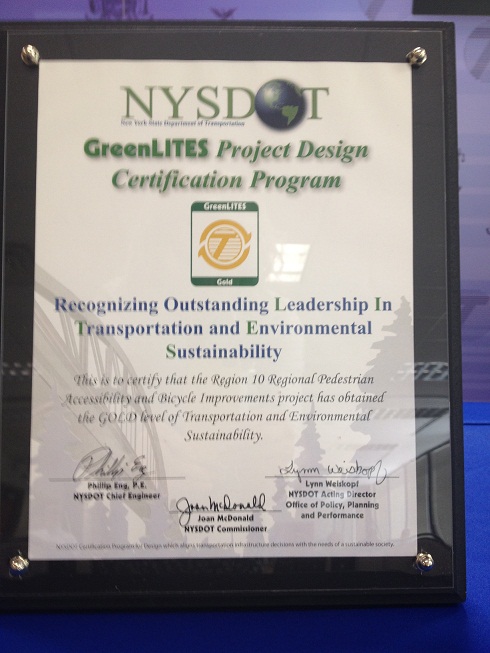
New York State Department of Transportation (NYSDOT) Commissioner Joan McDonald presented her staff with 11 awards Monday for project designs and maintenance operations that incorporate environmental sustainability. The awards, presented each year on Earth Day, are a product of the Department’s self-certification program, Green Leadership in Transportation and Environmental Sustainability (GreenLITES). Over the last five years, 890 projects across the state have been submitted for potential certification and recognition, with one of the first being the Vision Plan for a “Green” Route 347.
One of the top awards went to the “Regional Pedestrian Accessibility and Bicycle Improvements” project in Nassau and Suffolk Counties that will be focused around multi-modal connections to railroad stations, bus stops, state parks and downtown destinations. The project will include 8,000 feet of new sidewalk links, upgrades to about 20 miles of existing bicycle routes, approximately three miles of new bike lanes and high-visibility staggered ladder crosswalks. The work will be done in the Towns of Oyster Bay, Babylon, Brookhaven, Islip, Southampton and East Hampton.
A project that makes pedestrian safety improvements to Route 9 in South Glens Falls (Saratoga County) was also recognized. The plan calls for pedestrian signals with countdown timers at all signalized intersections, and it also slightly reduces the curb-to-curb width of the roadway to provide either shared-use travel lanes or narrower paved shoulders, minimizing issues involving bicyclists and parked vehicles.
GreenLITES, which was started in 2008, is the first program of its kind in the country, and is based on the Leadership in Energy and Environmental Design (LEED) certification model used for buildings. Last year, the Federal Highway Administration recognized GreenLITES as a case study and model for the country. Projects are rated in categories that include:
[S]ite selection, water- and air-quality protection, the minimization of waste, reduced energy use and innovation. Examples of design elements that scorers might rate highly include those that protect, enhance or restore fish and wildlife habitat, minimize storm water runoff, improve traffic flow, reduce energy and petroleum consumption, improve bicycle and pedestrian facilities and minimize noise and stray light.
Currently, the Department uses this voluntary program as a way to encourage and identify innovation and best practices. The next logical step will be for NYSDOT to take these best practices and make them required practices for all of the State’s transportation projects. To take the GreenLITES program even further, NYSDOT should better integrate transportation projects with land use decisions, with an emphasis on smart growth and transit-oriented development.
